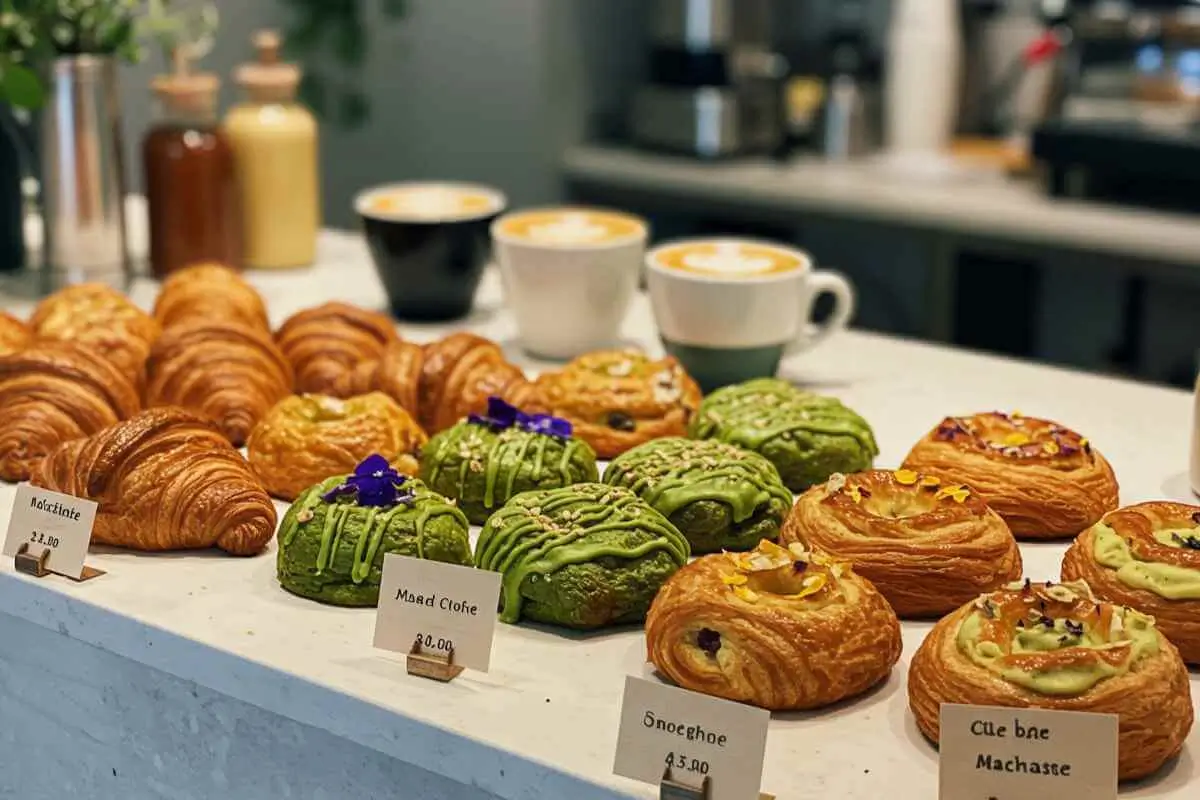Introduction
What Are Breakfast Pastries?
Breakfast pastries are a delightful category of baked goods enjoyed across the globe, often served as a sweet or savory start to the day. From buttery croissants to flaky danishes, these treats combine various ingredients such as flour, butter, sugar, and sometimes fruit or cream fillings. They are typically enjoyed alongside coffee, tea, or juice, offering an indulgent, satisfying experience for breakfast lovers.
Historically, breakfast pastries emerged from different culinary traditions and have evolved into an iconic staple of both bakeries and home kitchens. While they originated in Europe, their popularity has spread worldwide, with regions adapting the basic concepts to create their unique versions.
In this article, we’ll explore the fascinating world of breakfast pastries, delving into their history, types, techniques, and cultural significance. Whether you’re a pastry enthusiast or a novice baker, this guide has everything you need to know.
History of Breakfast Pastries
Origin of Pastries
Pastries trace their roots back to ancient civilizations, where early bakers experimented with dough, honey, and nuts to create the first forms of these treats. The Egyptians were among the first to develop rudimentary pastry-like bread, but it was the Greeks and Romans who began filling these baked goods with fruits and sweeteners.
By the Middle Ages, the craft of pastry-making flourished across Europe. Techniques such as laminating dough to create layers and puff pastry were refined, thanks to innovations from French and Austrian bakers.
Evolution of Breakfast Pastries Globally
The concept of breakfast pastries truly began to take shape during the 17th and 18th centuries. In France, croissants became synonymous with breakfast culture, while Denmark introduced the now-famous Danish pastry. The industrial revolution played a significant role in popularizing these items, as more accessible ingredients and tools allowed home bakers and commercial establishments to replicate traditional recipes.
Cultural Significance of Breakfast Pastries
Breakfast pastries are more than just food—they are symbols of comfort, warmth, and indulgence. In France, it is a daily habit to visit the bakery and enjoy a fresh pastry in the morning. In the United States, popular breakfast pastries like muffins and cinnamon rolls are common in diners and cafés, providing a familiar and satisfying way to start the day.
Types of Breakfast Pastries
Classic European Pastries
European pastries set the gold standard for breakfast baked goods, with several varieties becoming international favorites:
Croissants
The croissant, with its buttery layers and crescent shape, is perhaps the most iconic breakfast pastry. It originated in Austria but gained worldwide acclaim through French innovation. A classic croissant requires careful lamination of dough and butter to achieve its flaky texture.
Danish Pastries
Known for their sweet fillings and decorative designs, Danish pastries feature custards, jams, or fruit toppings. They originated in Denmark but have since evolved to include local ingredients and flavors in different regions.
American Breakfast Pastries
In the United States, breakfast pastries often lean toward sweeter and more decadent options, such as:
- Muffins: A versatile pastry that can be sweet (e.g., blueberry) or savory (e.g., cheddar and chive).
- Cinnamon Rolls: Sticky, gooey, and spiced with cinnamon, these rolls are a popular choice for a special breakfast.
Asian-Inspired Pastries
Asian countries have embraced breakfast pastries with unique interpretations, such as:
- Japanese Melonpan: A sweet, fluffy bun with a crispy, cookie-like crust.
- Chinese Egg Tarts: A flaky pastry filled with creamy custard, often served warm.
Middle Eastern and Mediterranean Breakfast Pastries
These regions boast pastries that often incorporate nuts, honey, and aromatic spices:
- Baklava: Layers of phyllo dough filled with nuts and sweetened with syrup or honey.
- Borek: A savory pastry filled with cheese, spinach, or meat, popular in Turkey and surrounding countries.
Ingredients Used in Breakfast Pastries
Essential Ingredients
The foundation of breakfast pastries lies in a few staple ingredients:
- Butter: Responsible for creating the signature flakiness and rich flavor of pastries.
- Flour: The structure of most pastries relies on high-quality wheat flour.
- Sugar: Adds sweetness and aids in caramelization during baking.
Flavor Enhancers
To elevate the taste, bakers often incorporate:
- Vanilla Extract: A popular flavoring in sweet pastries.
- Spices: Such as cinnamon or nutmeg, for added warmth and complexity.
- Fruits: Fresh or dried fruits, such as berries, apples, or raisins, contribute natural sweetness and texture.
Special Ingredients for Healthier Options
With growing demand for health-conscious options, bakers now use:
- Whole Grains: For added fiber and nutrients.
- Sugar Substitutes: Such as honey, agave syrup, or stevia.
- Plant-Based Alternatives: Like almond milk or coconut oil for vegan-friendly pastries.
Baking Techniques for Breakfast Pastries
Traditional Baking Methods
Creating bakery-quality pastries requires precise techniques, including laminating dough for puff pastry and proofing yeast-based doughs for proper rise and texture.
Tips for Perfecting Puff Pastry
- Keep butter cold and handle the dough minimally to maintain its structure.
- Allow the dough to rest between folds to relax gluten.
Easy Home Baking Techniques for Beginners
For home bakers, simplified methods such as pre-made puff pastry or no-knead dough can save time without compromising flavor.
Common Mistakes to Avoid
- Overmixing the dough: This can result in tough, dense pastries.
- Skipping resting time: Leads to uneven layers and poor texture.
Popular Breakfast Pastries by Region
Europe (France, Italy, Denmark)
Europe is the birthplace of some of the world’s most iconic breakfast pastries, many of which have achieved global fame.
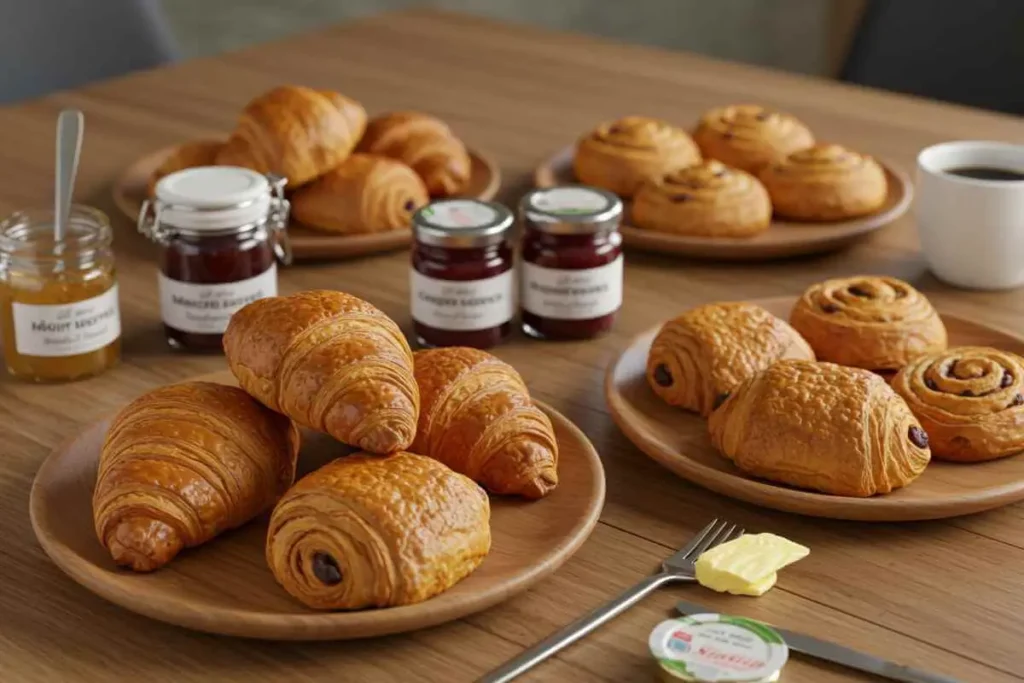
- France:
Croissants and pain au chocolat are staples on French breakfast tables. These buttery pastries are often enjoyed fresh from local boulangeries, accompanied by jam, butter, or a hot cup of coffee. - Italy:
Italian breakfasts often feature cornetti, which are slightly sweeter and softer than croissants. These delicious pastries are commonly filled with custard, fruit jam, or Nutella, adding an indulgent touch to the morning meal. - Denmark:
Denmark is known for its famous Danish pastry, or wienerbrød. These pastries come in various shapes and are filled with ingredients like almond paste, custard, or fruit preserves.
North America (USA, Canada)
North American breakfast pastries are known for their rich flavors and indulgent profiles, offering a sweet and hearty start to the day.
- USA:
Muffins, cinnamon rolls, and sticky buns are widely loved and commonly found in bakeries and cafes. Additionally, bagels with sweet toppings like cream cheese and fruit spreads are a popular breakfast choice. - Canada:
In Canada, butter tarts take center stage. These pastries, filled with a sweet buttery syrup and sometimes nuts or raisins, are a beloved classic.
Asia (Japan, India)
Asia introduces unique flavors and textures to the world of breakfast pastries, blending tradition with creativity.
- Japan:
In Japan, soft and fluffy breads like shokupan and melonpan are breakfast favorites. These pastries are often enjoyed with coffee or tea, offering a subtle sweetness that pairs well with beverages. - India:
While savory dishes dominate Indian breakfasts, sweet pastries like khaja are also enjoyed. This crispy, layered treat is soaked in sugar syrup, making it a decadent morning option.
Africa (Morocco, South Africa)
Africa’s breakfast pastries blend local flavors with global influences, resulting in unique and flavorful creations.
- Morocco:
In Morocco, msemen is a popular choice. This flaky, layered flatbread is served with honey or jam for a simple yet satisfying breakfast. - South Africa:
South Africa’s koeksisters are a true treat. These braided pastries are deep-fried and coated in syrup, making them a sweet indulgence that pairs perfectly with morning coffee or tea.
Healthier Breakfast Pastry Options
Low-Calorie Pastries
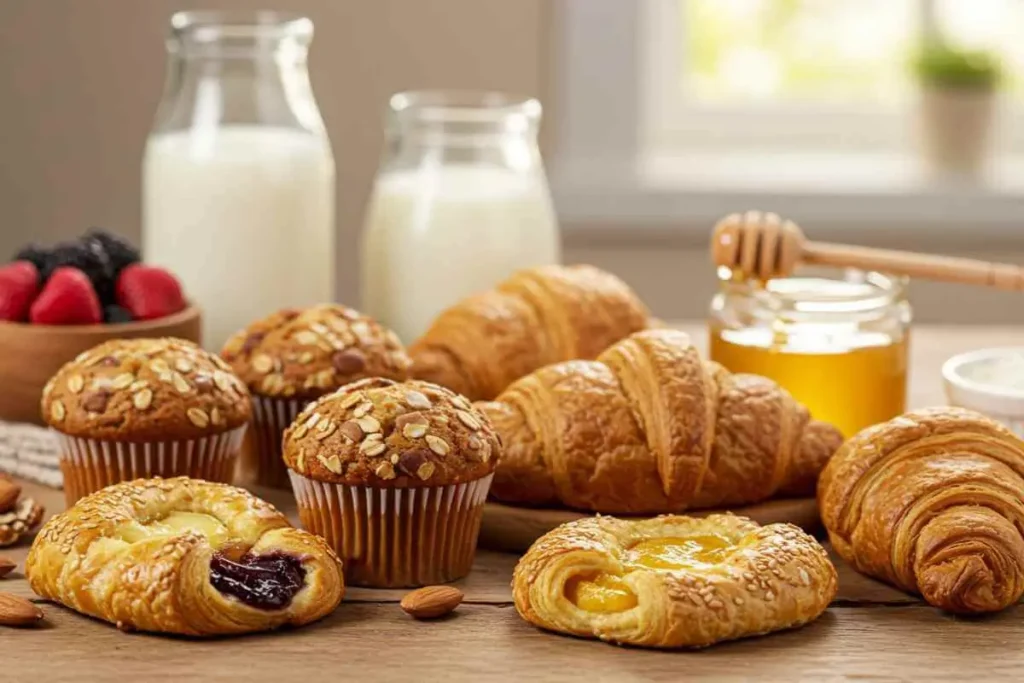
For those looking to enjoy pastries without the guilt, options include:
- Whole-grain scones with dried fruit.
- Reduced-sugar muffins made with natural sweeteners like applesauce or honey.
Vegan and Dairy-Free Pastries
With the rise in plant-based diets, many bakeries now offer:
- Vegan croissants made with margarine or coconut oil.
- Dairy-free danishes with almond milk-based custards.
Gluten-Free Pastries
For individuals with gluten sensitivities, these options are popular:
- Almond flour muffins.
- Gluten-free puff pastry made with a mix of rice and tapioca flours.
Sugar-Free Pastries
Sugar-free options cater to those monitoring their sugar intake:
- Pastries sweetened with stevia or erythritol.
- Naturally sweetened turnovers with fruit-only fillings.
The Role of Breakfast Pastries in Modern Food Trends
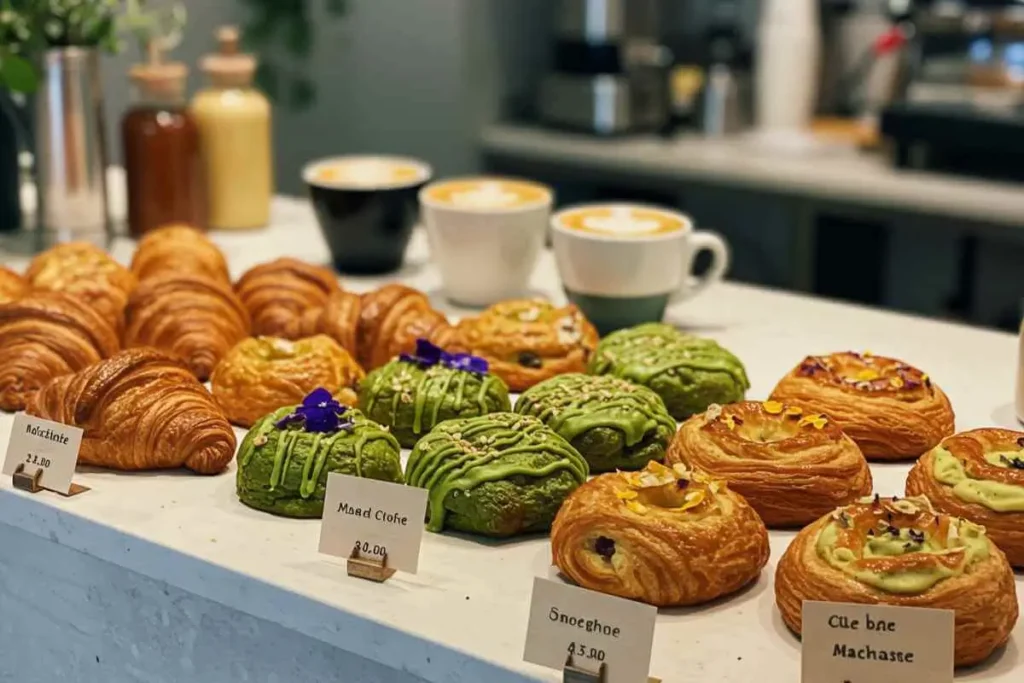
Breakfast Pastries in the Café Culture
Breakfast pastries have become an essential part of café menus worldwide. In many cafés, these pastries are served alongside specialty coffee, which elevates the overall dining experience. Furthermore, the pairing of a freshly baked croissant with a perfectly brewed latte creates a luxurious and relaxing morning ritual for customers. This trend has helped establish breakfast pastries as a staple in the café culture.
Artisanal Pastries and Gourmet Options
The artisanal movement has significantly elevated breakfast pastries, transforming them into gourmet creations. Bakers now experiment with unique and exotic ingredients, such as matcha, black sesame, and even edible flowers, to craft pastries that are both innovative and visually stunning. Additionally, these high-quality pastries appeal to those seeking premium and handcrafted breakfast options, making them a favorite among food enthusiasts.
Pastries in Social Media and Food Photography
The rise of social media platforms, especially Instagram, has brought breakfast pastries into the spotlight. Vibrant images of flaky croissants, colorful danishes, and intricately designed pastries dominate food photography feeds. As a result, these visually appealing creations have turned into a major food trend. Moreover, the aesthetic charm of breakfast pastries continues to inspire bakers and influencers, further boosting their popularity across the globe.
How to Pair Breakfast Pastries
With Coffee and Tea
Pairing pastries with the right beverage enhances their flavor:
- Croissants pair beautifully with a latte or cappuccino.
- Fruit-filled pastries complement herbal teas like chamomile or mint.
With Fresh Fruits and Yogurt
Adding fresh fruits or a side of Greek yogurt is a simple way to balance the richness of pastries while making your breakfast more nutritious. For example, you can enjoy a blueberry muffin alongside a handful of fresh strawberries. Similarly, pairing a Danish pastry with plain yogurt and a drizzle of honey creates a well-rounded and satisfying meal.
With Savory Sides (Cheese, Eggs)
Savory sides complement sweet pastries perfectly and can create a delightful balance of flavors. For instance, creamy Brie cheese works beautifully when served with a buttery croissant. Moreover, scrambled eggs can pair wonderfully with a slightly sweet scone, making your breakfast both flavorful and filling.
DIY Breakfast Pastry Recipes
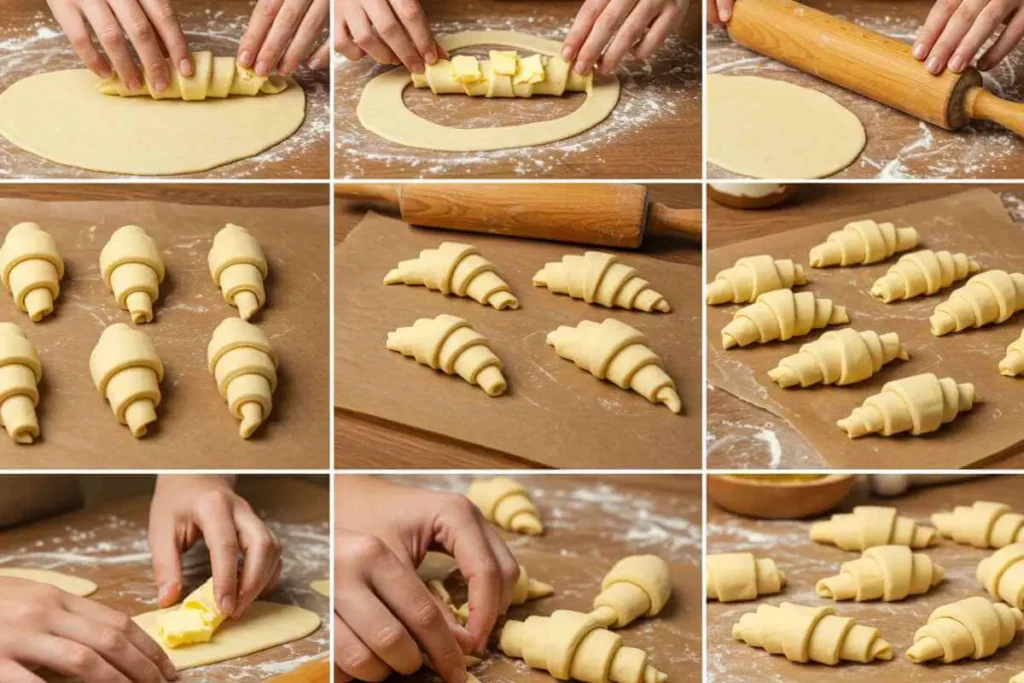
Easy Croissant Recipe
Ingredients: Flour, butter, yeast, sugar, and salt.
Steps:
- Prepare the dough and let it rest overnight.
- Roll out the dough, layer with butter, and fold multiple times.
- Shape into crescent forms and bake until golden brown.
Quick Danish Pastry Recipe
Ingredients: Puff pastry, fruit jam, and custard.
Steps:
- Cut puff pastry into squares and add a dollop of jam or custard in the center.
- Fold the edges to form decorative shapes.
- Bake at 375°F (190°C) until golden and flaky.
Healthier Muffin Recipe
Ingredients: Whole wheat flour, mashed bananas, honey, and almond milk.
Steps:
- Combine the dry and wet ingredients separately, then mix.
- Pour into muffin tins and bake for 20 minutes.
Tips for Modifying Recipes to Your Taste
- Add nuts, dried fruits, or chocolate chips for extra flavor.
- Substitute ingredients like coconut oil for butter to cater to dietary preferences.
Frequently Asked Questions (FAQs)
What are some common pastries?
Common pastries are croissants, Danish pastries, muffins, cinnamon rolls, and scones. These treats differ by region but are loved everywhere for their variety and delicious flavors.
What is a breakfast pastry in England?
In England, breakfast pastries often include scones served with clotted cream and jam, as well as puff pastry treats like Eccles cakes filled with dried fruits.
What are the five classic pastries?
The five classic pastries include:
- Croissants
- Danish Pastries
- Eclairs
- Tarts
- Profiteroles
What is a typical Italian breakfast pastry?
A typical Italian breakfast pastry is the cornetto, a softer, sweeter version of the croissant, often filled with jam, cream, or chocolate.
Conclusion
Breakfast pastries are a symbol of comfort and joy, offering options for every taste and culture. From buttery croissants in France to sweet and savory pastries in Asia, these treats bring flavor and happiness to mornings around the world.
Whether it’s a classic muffin, a flaky Danish, or a gluten-free option, breakfast pastries keep evolving while honoring their rich history. They are more than just food—they are an experience that pairs perfectly with coffee, tea, or even a smile.
By exploring their types, techniques, and cultural roots, we discover the creativity behind these beloved baked goods. Whether you bake at home or visit a local café, breakfast pastries are the perfect way to make mornings brighter.

